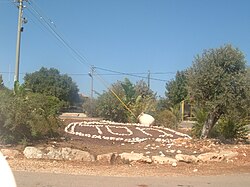| Masad מסד | |
|---|---|
 | |
 | |
| Coordinates: 32°50′38″N 35°25′22″E / 32.84389°N 35.42278°E / 32.84389; 35.42278 | |
| Country | Israel |
| District | Northern |
| Council | Lower Galilee |
| Affiliation | HaMerkaz HaHakla'i |
| Founded | 1983 |
| Population | 389 |
| Website | www.massad.org.il |
Masad (Hebrew: מַסָּד, lit. foundation) is a community settlement in northern Israel. Located to the west of the Sea of Galilee, it falls under the jurisdiction of Lower Galilee Regional Council. In 2022 it had a population of 389.
Name
Har Kotz: Mount Qotz (292 m), named for a priestly family that migrated to the Galilee from Jerusalem after the destruction of the Second Temple. See Hakkoz priestly family, who migrated to Eilabun.
Masad: 'foundation', taken from the description of Salomon's palace in 1 Kings 7:9: "All these structures ... from foundation (masad) to eaves were made of high-grade-stone."
History
The village was founded as Har Kotz in 1983 and later named after a biblical verse, dealing with the building of Solomon's palace.
Plans to build a quarry on Mount Kotz were rejected by the National Planning and Construction Council in 2008 after protests staged by the residents of Masad and the nearby Arab village of Eilabun.
2km to the northeast is Hurvat Mimlah (also Khirbet Mimla, PAL 191/251), the site of the ancient village of Mamliah (Hebrew: ממליח), seat of the Hezir priestly family following the destruction of the Temple in 70 CE. Today it is a ruin.
Nature reserve
Masad is surrounded by the Har Kotz Nature Reserve. Among the trees found there are carob, mastic, Mount Tabor oak, Christ's Thorn, Palestine oak, and Jerusalem thorn. The nature reserve derives its name from Mount Qotz (292 m), itself named after a priestly family that lived nearby.
See also
References
- ^ "Regional Statistics". Israel Central Bureau of Statistics. Retrieved 21 March 2024.
- ^ Hareuveni, Imanuel (1985). קום התהלך בארץ: מדריך שמורות טבע בישראל [Arise and walk through the land: a guide to nature reserves in Israel] (in Hebrew) (2nd ed.). Israel: Israel Ministry of Defense. p. 155. ISBN 965-05-0193-2.
שם השמורה – לפי שם ההר. שמו – לפי שמה של משמרת הכוהנים, אשר עברה מירושלים לגליל אחרי חורבן הבית השני." "במפנה הדר' גדלה חברת חרוב-מצוי ואלת-המסטיק. במפנה הצפ', בחלקו העליון, גדלה חברת אלון-מצוי, ובמורד, על קו הרכס – חברת אלון-התבור עם עצי שיזף-מצוי. על גבול השמורה גדלים עצי שמיר-קוצני (עץ נדיר בחורש הים-תיכוני). Redacted Google translation: The name of the reserve - according to the name of the mountain. Its name - after the name of the priestly order, which moved from Jerusalem to the Galilee after the destruction of the Second Temple. At the turn of Hadar, grows the plant community of haruv matzuy (carob) and elat hamastik (lentisk or mastic). In the north-west turn, in the upper part, grows the alon matzuy (Palestine oak) community, and on the downhill, on the ridge line - the alon haTavor (Mount Tabor oak) community with sheizaf matzuy (Christ's thorn jujube) trees. On the border of the reserve grow shamir kotzani (lit. 'prickly dill'), a rare tree in the Mediterranean horesh/garrigue-type woodland.
(see Genesis 13:17) - ^ Bitan, Hanna (1999): 1948-1998: Fifty Years of 'Hityashvut': Atlas of Names of Settlements in Israel , Jerusalem, Carta, p.40, ISBN 965-220-423-4.
- News in brief, Haaretz, 2008-02-07.
- Avi-Yonah, Michael (1976). "Gazetteer of Roman Palestine". Qedem. 5: 78. ISSN 0333-5844.
External links
- Village website (in Hebrew)
| Lower Galilee Regional Council | |
|---|---|
| Kibbutzim | |
| Moshavim | |
| Moshavot | |
| Community settlements | |
| Youth villages | |